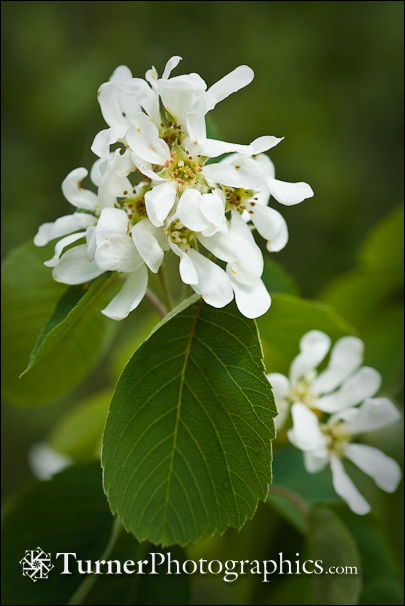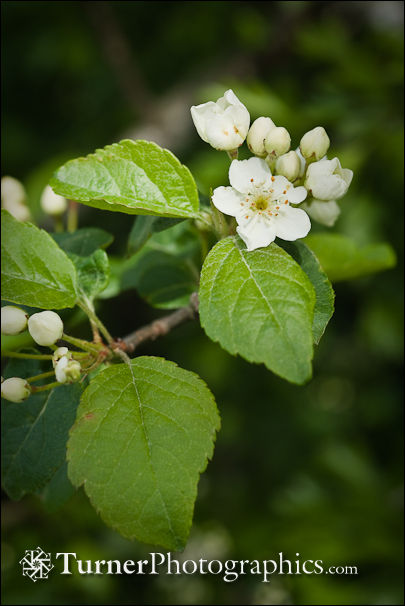Amelanchier Malus Rubus
 Try saying the title three times fast. If you’re not up on your botanical Latin maybe the words don’t quite roll off your tongue.
Try saying the title three times fast. If you’re not up on your botanical Latin maybe the words don’t quite roll off your tongue.
Anyway, what do these have in common? They’re all members of the rose family, Rosaceae, they’re all in bloom right now, and they all have tasty edible fruit later in the season.
The Amelanchier alnifolia, commonly called Serviceberry or Saskatoon, is a large shrub with masses of flowers with shaggy white petals. It’s native on both sides of the Cascades, smells sweet, and is showy along roadsides right now. My friend David Perry collected some for a bouquet over around Spokane a week or so ago and wrote about it on one of his blogs, A Fresh Bouquet. David is an exquisite photographer with a keen eye and discerning taste. If you’re not following his blogs you should be.
There are other species of Serviceberry in other parts of the country. I learned the name of this plant, pronounced “sarvisberry,” as a kid in West Virginia. Out there the species is Amelanchier arborea. Whatever you call it, the flowers will be followed by small dark purple fruit around mid-summer. I usually leave them for the birds, but they’re edible and often used for jams and jellies.
 A very desirable member of the family, Trailing Blackberry, is also blooming now. This is one of the tastiest of our blackberries if you can get to the fruit before the four-legged critters. It’s also one of the parents of horticultural hybrid blackberries. The canes, armed with prickly spines, clamber over the ground and over other small shrubs, forming a tangled mass that can easily trip an unsuspecting hiker.
A very desirable member of the family, Trailing Blackberry, is also blooming now. This is one of the tastiest of our blackberries if you can get to the fruit before the four-legged critters. It’s also one of the parents of horticultural hybrid blackberries. The canes, armed with prickly spines, clamber over the ground and over other small shrubs, forming a tangled mass that can easily trip an unsuspecting hiker.
You can easily distinguish Trailing Blackberry from its much larger non-native invasive cousin, Himalayan Blackberry. Trailing Blackberries are smaller, the canes are thinner, and they’re weak so they aren’t self-supporting. Himalayan canes are thick, stout, and strong so they arch upward. Trailing Blackberry fruit are relatively small, tight, and compact. Himalayan Blackberry fruit are much larger, with bigger seeds. Both are tasty whether eaten fresh or made into jam.
The Latin name for the native, Rubus ursinus, reflects one of those four-legged critters that love the fruit: bears. I don’t think we’re likely to find black bears dining on dewberries along Whatcom Creek in Bellingham, but up in the mountains it would be expected.
 The third of our edible roses today is Pacific Crabapple, Malus fusca. I spent a lot of time last year trying to find this small tree, working to distinguish it from escaped cultivated apples which are also quite common along roadsides and in the woods around Bellingham. Our native crabapple has smaller flowers that are generally almost pure white. Flowers on domestic apples usually are tinged with pink and the blossoms are larger. Another distinguishing characteristic is the leaves.
The third of our edible roses today is Pacific Crabapple, Malus fusca. I spent a lot of time last year trying to find this small tree, working to distinguish it from escaped cultivated apples which are also quite common along roadsides and in the woods around Bellingham. Our native crabapple has smaller flowers that are generally almost pure white. Flowers on domestic apples usually are tinged with pink and the blossoms are larger. Another distinguishing characteristic is the leaves.
Crabapple leaves are somewhat more pointed than domestic apple leaves and they often have a “thumb” or lobe on one side. Not all leaves will have the lobe, but if you examine a tree you’ll usually find many leaves with lobes.
Pacific Crabapple prefers moist habitats, even swampy ground, and also along saltwater shorelines just above the high tide line. It’s a small shrubby tree, rather messy in appearance.
I photographed all of these along the Whatcom Creek Trail just downstream of Whatcom Falls Park in Bellingham. The trail is only a couple of miles from my house. Much of this area has been replanted with natives following the disastrous gasoline spill and fire in 1999. You can see more photos from this full day of plant photography on my PNW Flowers website. I was battling breezy conditions, but found lots of subject matter.


Great shots and I really like you write-up!